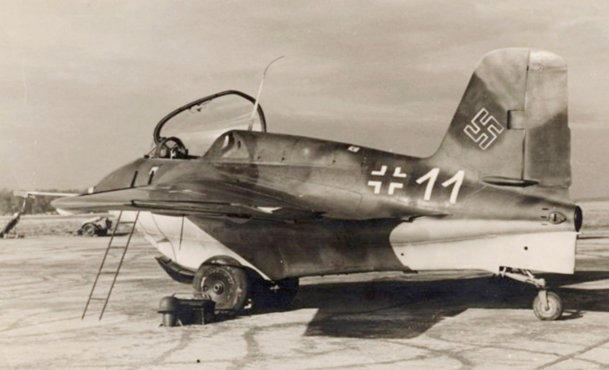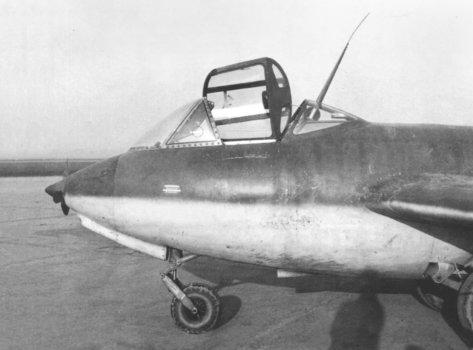
Alexander Lippisch after the war with a
model of the test aircraft DM-1 for his ramjet
fighter P 13.
One version of the many designs drawn by Alexander Lippisch for the new Me 263:
the project P 03 with two rocket engines.
The collaboration between Messerschmitt and Lippisch was not without problems, and
the two parted ways in 1943, after which the Messerschmitt company continued to
develop the Me 263 on its own.
However, as Messerschmitt was not on schedule with other aircraft projects, the
development of the new rocket fighter was handed over to the Junkers company. This
company now called the project the Ju 248.
The mockup shows the installation of MK 108
cannons in the wing roots.
Junkers took over the design of the Me 263 from Messerschmitt without many
changes and, after the Luftwaffe had inspected the mock-up, began building the
prototypes and preparing for series production in early 1945.
To overcome the problems with the landing skid of the Me 163, the
Me 263 (Ju 248) was equipped with a landing gear.
The Junkers company made only minor changes to the design of
Messerschmitt. The production of prototypes began in early 1945.

Text: English plus German
In the 1930s, the ingenious aircraft designer Alexander Lippisch worked on
designs for tailless fighter planes, first with propellers, then with rocket
propulsion. Under the umbrella of the Messerschmitt company, he created the
Me 163 rocket fighter, which reached 1004 km/h in a record flight - the fastest
aircraft of the Second World War.
The short range of the Me 163 and the landing on a skid led to the design of
a significantly improved version - the Me 263.


Messerschmitt Me 263 / Ju 248
The ultimate rocket-fighter
A short summary

The wooden mockup of the Ju 248 (Me 263) at
the Junkers company.
The US forces found Me 263 fuselages (amongst a lot of Reichenberg
fuselages) at the Fieseler works at Kassel - and had them scrapped.
















The fastest aircraft of ww2: the rocket fighter Messerschmitt Me 163.
The prototype of the new rocket fighter has been completed. The Ju 248 V1
flew for the first time on February 8, 1945, making its maiden flight without an
engine, being trailed behind a Bf 110.
The prototype Ju 248 V1 awaiting its next testflight.
The Russians showed more interest in the Me 263 and built two
experimental aircraft as the I-270 and flew them with rocket
propulsion.


The full story of the rocket fighter Messerschmitt
Me 263 with lots of photos, drawings, and
technical details.
A publication that should not be missed by anyone
interested in the Luftwaffe or aviation technology.

Print or Kindle-eBook:

Sample pages








